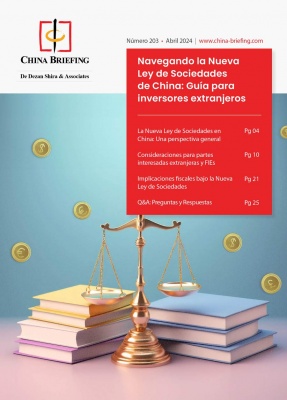China’s 2011 Tax Revenue from Non-resident Enterprises Hits Record High
Non-resident enterprises should be careful about their financial strategies to avoid unexpected and unnecessary tax exposure in China
Mar. 13 – China’s State Administration of Taxation (SAT) announced that its tax revenue from non-resident enterprises (NREs) reached RMB102.6 billion (US$16.16 billion) in 2011, exceeding RMB100 billion for the first time and reporting a 31.8 percent increase from a year earlier. Although this amount only accounts for roughly 1.1 percent of China’s total tax revenue last year, the high growth rate underscores the government’s increasing attention to this particular group of taxpayers.
Among a variety of taxes collected from NREs, corporate income tax (CIT) plays a major role and takes up around 85 percent of the group’s total tax imposition. NREs’ total CIT contributions in 2011 reached RMB87.2 billion, seeing a rapid increase of 38.4 percent from 2010.
In particular, China’s SAT has made remarkable progress in deducting CIT at source (withholding CIT), which totaled RMB75.3 billion last year and showed year-on-year growth of 45.9 percent.
This growth in CIT revenue owes thanks to the 2008 CIT Law, which introduced definitions for resident enterprises (REs) and NREs for the first time. The Chinese government has also issued over 30 official documents regarding tax collection from NREs in an effort to strengthen the scrutiny of NREs’ China-derived incomes.
The contribution of various types of corporate income to SAT’s total CIT collection from NREs is as follows:
- Dividend income: 51.6 percent
- Royalties income: 21.8 percent
- Equity transfer income: 10.2 percent
- Other income (such as income from interest and services): 16.4 percent
Dividends
Many foreign investors’ desire for cash during the recent Global Financial Crisis has resulted in the considerable year-on-year growth (63.6 percent) of withholding tax on dividends in 2011.
Dividends repatriation is subject to a withholding tax rate of 10 percent, according to Chinese regulations. However, lower tax rates may be applied to such income based on tax treaties China has signed with specific foreign governments.
With Chinese tax authorities’ knowledge and skills improving in dividend income inspection, NREs should be more careful with their cash repatriation strategy. It is necessary to first gain a thorough understanding of the tax treaty benefits one is entitled to, and become fully prepared for possible administrative matters.
Royalties
As a country experiencing rapid development in its technology-intensive industries, China is seeing a large influx of royalty transfers from developed countries with more advanced technologies and name brands. Therefore, withholding CIT on royalties has become the second-largest contributor to the SAT’s CIT revenue from NREs, growing by around 20.7 percent in 2011 from a year earlier.
While royalty transfers may come together with technology-related services, the Chinese government has released several documents concerning how to distinguish royalties from services, and what the tax treatment is in the context of specific tax treaties. Foreign investors should be aware of those principles and get a grasp of their actual entitlement to tax treaty benefits.
Pricing of royalties is becoming another point of focus during SAT’s tax inspections. NREs are advised to fully assess their pricing policies – especially for related party transactions – to avoid the risk of a tax adjustment, which could lead to an increase in tax payments.
Equity transfers
CIT on equity transfers in 2011 grew steadily by 36 percent, in part because the external economic downturn has increased equity transfer activities from non-resident shareholders to REs. The SAT’s largest single-source tax revenue in 2011 – amounting to RMB674 million – was paid by a Hong Kong-based NRE during Nestlé’s acquisition of the Chinese food company Yinlu.
Pricing is again an essential factor which NREs should pay attention to during the process of equity transfers. In recent years, the SAT has strengthened its information sharing and exchange capabilities with other government departments – including the Ministry of Commerce, the Administration for Industry and Commerce and the Administration of Foreign Exchange – to gain a better knowledge of equity movements between REs and NREs and the reasonable pricing levels of equity transfers. Prices considered “unreasonably low” during equity transfers may face SAT-forced adjustments.
NREs planning to conduct equity transfers for internal group restructuring purpose shall also make sure they act in accordance with related laws. In 2009 and 2010, the Chinese government issued two critical documents (caishui [2009] No.59 and SAT Announcement [2010] No.4) regarding CIT treatment and management on various types of corporate restructuring. The documents cover changes in legal structure, debt restructuring, equity acquisitions as well as asset acquisitions, mergers and divisions.
Dezan Shira & Associates is a boutique professional services firm providing foreign direct investment business advisory, tax, accounting, payroll and due diligence services for multinational clients in China, Hong Kong, India, Singapore and Vietnam. The firm specializes in assisting foreign enterprises with their tax obligations. For further advice, please email china@dezshira.com, visit www.dezshira.com, or download the firm’s brochure here.
Related Reading
 The China Tax Guide (Fifth Edition)
The China Tax Guide (Fifth Edition)
This popular book, fully updated with all recent tax changes and amendments, details all taxes in China affecting businesses and individuals, how to calculate the amounts due, tax registration and filing procedures, tax minimization techniques, and claiming VAT rebates. It also details good financial management techniques, handling negotiations with the tax bureau and annual audit and compliance procedures.
Six Key Points Regarding China’s Tax Reforms in 2012
Shenzhen Specifies Taxable Project Filing Details for NREs
SAT Issues Announcement Clarifying Circular on Equity Transfers
SAT Releases Tax Exemption Guidelines for Overseas Corporate Income
- Previous Article Report: China’s 2020 Consumer Demographics
- Next Article China Takes Further Steps Towards Internationalizing the Renminbi
























